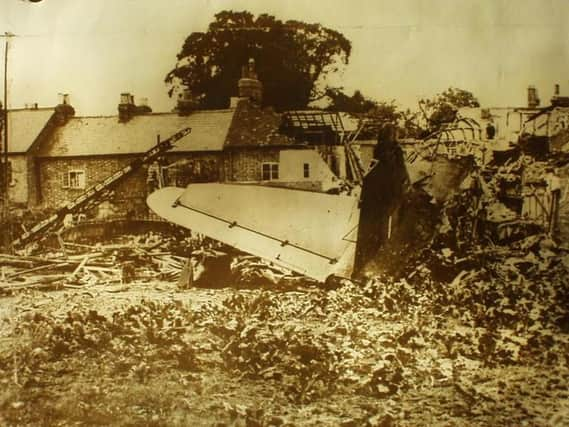FEATURE: The Winslow aircrash of 1943


In the early hours of 7 August 1943, a Wellington X3790 Mark III bomber of 26 Operational Training Unit crashed on Winslow while making a second attempt to land at Little Horwood Airfield.
The crew was:
Sgt Pilot Wilfred Davies
Sgt Navigator Jeffrey Harrington (the only survivor)
Sgt Wireless Operator / Air Gunner Valentine (Jock) McKeon
Sgt Bomb Aimer John Sowter
Australian Flight Sgt Clive Fietz
Advertisement
Hide AdAdvertisement
Hide AdThe plane struck a walnut tree and hit the roofs of houses on the west side of the High Street (around no.75).
It ploughed through the Chandos Arms and the adjacent house (no.82) on the other side of the street, then came to rest on Rose Cottages, a row of four houses behind the High Street, roughly where the British Legion Hall is now.
Three of the cottages burned down as the plane caught fire.
There were 13 civilian fatalities:
Thomas Cox, landlord of the Chandos Arms.
Tom Paintin of 82 High Street and his son Donald, both members of the
Fire Brigade.
William and Nora Hawkins. Mr Hawkins was a blacksmith and bell-ringer.
Advertisement
Hide AdAdvertisement
Hide Ad Stephen and Doris Mullis and their children Terence and Kathleen.
Israel and Annie Goldberg, their daughter Lottie Hobermann and her son Victor. The family had been evacuated from Stoke Newington after their house there was bombed.
George Hawkins, one of the firemen who led the effort to put out the fires, found that his parents had been killed. He and several other rescue workers were injured by the flames, exploding ammunition and flying asbestos tiles.
The Rescue and Demolition Squads were able to get survivors out of the burning buildings. Several people were saved by their iron bedsteads when their houses collapsed.
Advertisement
Hide AdAdvertisement
Hide AdDennis writes: "I was seven in August 1943 when the Wellington crashed in the High Street.
We were living in Sheep Street, no. 15, next to the gates of Winslow Hall and adjacent to the RAF Guardroom. Dad was a Post Office engineer and looked after telecommunications in the RAF Training Command HQ as well on Little Horwood airfield.
"I knew nothing about the crash until the next morning. Dad had been at the crash scene and had alarming tales to tell. I seem to remember him saying that because of the heat, loose machine-gun bullets were fizzing through the air.
"I must have misunderstood him, for surely there would have been even more deaths. But I certainly knew that something terrible had happened.
Advertisement
Hide AdAdvertisement
Hide Ad"When, later on, I saw the damage in the High Street, it really seemed that the Blitz had followed us from Kent and RAF Biggin Hill, where Dad had worked before being severely shell-shocked in the Luftwaffe air raid in August 1940.
"The children who died brought the crash very close to home.
"I still remember Terry and Kathleen Mullis and the Hobermanns, especially Victor, who was my age and in Miss Hawes’s class at school. I still have a sharp mental picture of him sitting at the back of the classroom.
"I knew that the family was evacuated to Winslow after being bombed out in London, but I have often wondered if this was their full story.
Advertisement
Hide AdAdvertisement
Hide Ad"Had something more sinister already happened to them? In which case, Victor’s death would be a doubly cruel irony which, for me, sums up the random, tragic fatuity of war, just as the crash itself does.